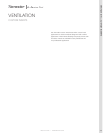
1.800.735.4328 | THERMADOR.COM
VENTILATION — DOWNDRAFT
DOWNDRAFT FEATURES & BENEFITS
CHOOSING THE RIGHT CFM
The power of the cooktop, measured in BTU, is
perhaps the most important factor in determining
CFM needs for a hood. Professional Gas Rangetops
generally should have 1 CFM for every 100 BTU.
You should also consider the cooking space and
cooking style of your client.
• More demanding cooks usually require more
exhaust capacity to handle moisture generated
by boiling large pots of water or the grease
and smoke resulting from grilling or frying. This
cooking style could require a hood or downdraft
system with airflow of 600 to 1,300 CFM.
• For those who are used to preparing quick
meals in a relatively small kitchen, a hood with
600 CFM may be adequate ventilation for the
cooking space.
• If the cooking surface is in a peninsula or island, a
larger capacity hood can provide better capture
when there are cross currents and when the
hood needs to be mounted higher. Downdraft
ventilation systems are also a good alternative.
• High heat cooking or aromatic foods may require
additional CFM. Increasing capture area by 3" on
each side is also a recommended way to address
this issue.
LENGTH AND SIZE OF DUCTWORK
Do not use flexible duct; it creates back pressure/air
turbulence and reduces performance.
Straight runs and gradual turns are best. Use the
shortest route with the fewest turns possible.
Proper performance is dependent upon proper
ducting. Use a qualified and trained installer. Local
building codes may require the use of make-up
air systems when using ducted ventilation systems
greater than specified CFM of air movement. The
specified CFM varies from locale to locale. Consult
your HVAC professional for specific requirements in
your area.
If using a 10" duct, Thermador recommends not
exceeding 150 feet of duct. Transitions, elbows and
wall or roof caps are all factors that will add more
static pressure, therefore increasing your equivalent
duct run.
WARRANTY
Limited warranty parts and labor (1 year)
See page 294 for additional warranty details.
185
BLOWER OPTIONS
REMOTE Requires CV2T6 Transition
VTR630D – 600 CFM Use RFPLT600 in roof-mount applications
VTR1030D – 1000 CFM Use RFPLT1000 in roof-mount applications
INLINE Requires CV2T6 Transition
VTI610D – 600 CFM
VTI1010D – 1000 CFM
INTEGRATED
VTN600CV2C – 600 CFM
See page 145 for further details.
VTR630D 600 CFM VTR1030D 1000 CFM
REMOTE (Mounted to roof or external wall) INTEGRAL (Mounted on hood)
VTI610D 600 CFM VTI1010D 1000 CFM
INLINE (Mounted between kitchen and external wall)
VTN600CV2C 600 CFM
REMOTE BLOWER ACCESSORIES
RFPLT600, RFPLT1000 – Roofplate Material
For use with Remote Blowers VTR630D and VTR1030D
Combinations
Roofplate Remote Blower
RFPLT600 VTR630D
RFPLT1000 VTR1030D
Overall Dimensions
Model No. A B C Duct Size
RFPLT600 7
1
/2" 8
1
/2" 9
1
/4" 6"
RFPLT1000 9
3
/8" 12" 11
1
/8" 10"
CV2T6 TRANSITION
Transition piece required for installation of inline and
remote blowers – downdraft applications only


















